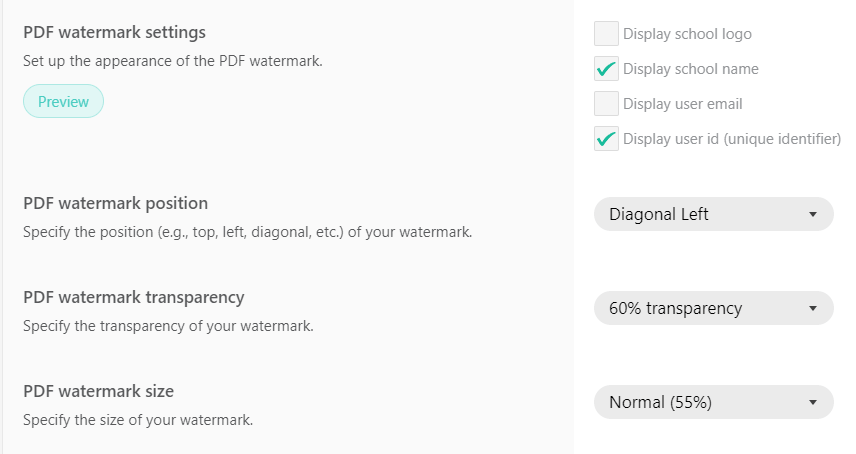Table of Contents
*LearnWorlds is the only course platform that offers a full suite of intellectual property protection and anti-piracy features*
Are you worried that your educational content might get copied, pirated, or stolen?
After all, you’ve spent countless hours storyboarding your course, shooting training videos, and creating course materials. You don’t want all that publicly shared over the internet or, worse, some impostor selling your courses and profiting off your hard work.
While no technology can 100% protect your online content from being stolen, you can definitely do a lot to make it hard for anybody to steal and reuse your intellectual property, i.e., your content.
Here at LearnWorlds, we’ve worked hard to help you safeguard your online course content. We’ve developed a comprehensive set of features to protect your online content against copyright infringement, like unauthorized/unlawful reproduction and distribution.
In fact, LearnWorlds is the only course platform offering built-in copyright protection functionality, meaning you don’t have to spend time and money on third-party products to get a similar result.
Let’s find out how our latest copyright protection features, along with other hacks you can implement on your own, will effectively protect your school and profits.
Table of contents
What is Intellectual Property?
Intellectual property (IP) is a category of property that includes intangible creations of the human intellect. It’s a broad term that includes scientific, literary, and artistic work, patents, trademarks, names, logos, and more.
In the context of course creation, almost everything you have created as part of your course and website is considered intellectual property:
Is It Easy for Someone to Steal Your Intellectual Property?
Let’s face the truth … it’s the Internet, and we can’t even list all the ways someone can copy, record, or download even from the most secure sites. When companies like Disney, Netflix, and Microsoft get pirated all the time, what can you, a humble course creator, do to prevent illegal downloads and redistribution of your work?
So the real question is not if it’s easy for someone to steal your intellectual property. But, once they’ve stolen – say, an online course video or an entire e-learning course – how easy is it for them to reuse it?
Well, it’s not. Depending on the measures you’ve taken to make your content unique, identifiable, and clearly linked back to you, it can be very hard for the thief to erase your tracks.
Removing elements like watermarks and time stamps will leave traces and significantly reduce the quality of the content, making it less than desirable and fit for making a profit. So good news – you’re pretty strong on this front!
Make the thieves work hard, so they don’t even get into the temptation of stealing your content.
How to Protect Your Intellectual Property: 9 Unmistakable Hacks
So, without further ado, here are 9 great hacks you can employ to keep bad guys away from your content.
#1 Show Your Face
Sounds obvious? If you have a lot of video content, make sure you appear at several points during each and every video. This will automatically claim the video as yours and make it obvious to anyone watching, even if they didn’t buy the course from you, that you’re the subject matter expert.
Plus, it will make it extremely difficult to cut you out of the video without the audience noticing that something’s not right.
💁 Feeling shy in front of the camera? These top tips from Matthew Pierce will get you rolling… quite literally!
#2 Watermark & Stamping
Include your name, logo, and website URL in your content in a video watermark, or a unique stamp on your PDF files. This way, even if your content is stolen, it is “marked” with unique characteristics that point back to your website and cannot be used by others as their own.
You can additionally choose to add a watermark of the user’s email or id, making any pirated content traceable back to the user that did it or allowed it to happen. Fear of being discovered is the number one deterrent against piracy.
#3 Add Dates (Time Stamp)
From your online course videos to blog posts and eBooks, everything you create either automatically mentions or should manually have a publish date added.
Adding dates to every piece of content you publish secures it with proof that you’re the original owner/creator.
#4 Create a Unique Learning Experience
It might not sound like a way to counter piracy, but it is. Customers do not pay just for a “plain” video or a PDF download.
Customers pay for an experience, a certificate, the online learning community, and for interacting with you, the expert instructor, and their peers.
What makes your course unique is all the things a copied course cannot provide: the constant updates you make to your content, the interaction among learners in discussion forums and groups, the live webinars and workshops, and the personalized feedback and guidance from you.
#5 Copyright/Trademark Your Work
The copyright law in the US and the respective legislation in Europe, help protect your creative works, with copyright protection being granted automatically.
You can include a copyright notice on your website (“all rights reserved”), along with the year you created the content and the copyright symbol ©.
If you’re based in the US, you can register the copyrights of your work at the US Copyright Office or trademark your branding at the US Patent and Trademark Office.
It’s not a cheap option, though. Therefore, we wouldn’t recommend going as far as filing copyright and trademark claims unless you have good reason to believe your work is in jeopardy and need to maintain exclusive rights to it officially.
#6 Create Your Own Copyright Policy
You have the right to create your own “terms and conditions” and communicate what you consider to be fair use of your content and what not.
Of course, this doesn’t legally protect you or give you any rights, as it’s not an official policy. Even so, it can prevent people who mean harm from mishandling your content unintentionally.
#7 Don’t Allow Multiple Logins
The more “guests” you allow to your courses, the more likely it is there will be a malicious factor among them. For this reason, it pays to disable multiple sessions and therefore limit the practice of password sharing. By doing so, the user who logged in to the account first will be automatically logged out once another user logs in.
#8 Limit User Actions in PDF Files
Most instructors offer eBooks, infographics, and other text-based learning material in PDF format. You can restrict what learners can do when accessing a PDF, and disable downloads or copying the text.
Of course, this is a rather extreme measure, as learners may want to copy text simply to save it as a note or download it on their device to view it later.
#9 Stay Alert
After you’ve done everything you could to protect your content, you now need to play detective and uncover malicious activities yourself. How?
🧑⚖️ When to talk with a lawyer: In extreme cases where someone might try to sell your content as theirs, you will need to address the situation by taking legal action.
You can try contacting the person responsible, the platform that allows the sale of the stolen goods to take place, asking them to take the content down, or even contact a legal expert on how you can address the situation.
Seems like quite a lot of work to protect your intellectual property, right?
How about we take some of it away? Talking with thousands of course creators using our platform, we have done multiple updates to our platform over the last few years, enhancing security and privacy features.
LearnWorlds Built-in Intellectual Property & Copyright Protection
When looking to host online courses, you need to take into account the security of the platform. Fortunately for you, LearnWorlds has built-in features to counter piracy and account sharing, so you don’t need to worry about adding any third-party tools and plugins at an extra cost to do it.
You can find a complete guide on how to enable video watermarking & PDF stamping on LearnWorlds here.
Video Downloading Restrictions
Videos uploaded and hosted on LearnWorlds use domain-restricted access, which means, a non-logged-in user cannot access or can’t download them. We also restrict by default any downloading or saving option. An average user can’t copy, save or download the videos in your LearnWorlds account.
Video Watermarking
Using LearnWorlds, you can enable the Video Watermark settings to show unique identifiers on your videos. You choose a combination of the following:
These can show up in different places or in random rotations around the video to prevent screen recorders from getting your content and sharing it.
It’s important to know that this is a watermark that is displayed on your video to discourage and identify content pirates who use screen recorders and mobile phones or cameras to capture video.

*A sufficiently sophisticated and motivated malicious actor could still get the original video, without the watermark, by using special software. Unfortunately, nothing can be done here. To watermark a source video, you would still need to use special video editing software to add your logo & name to the video before uploading it to LearnWorlds.
PDF Protection – Disable Download, Copy & Print
Depending on your teaching style, you might want to give access to your PDF files or fully restrict learners from taking any action besides opening and scrolling through them.
From the copyright protection settings, you can choose the level of security you want for your PDFs:
If you enable these settings, but still want to give a downloadable PDF in some units, you can attach the pdf as a digital download.

LearnWorlds’ interactive eBook is a safer alternative than uploading PDF files to your course. Creating an eBook enables your students to take notes and highlight, and allows for video embedding. Adding functionality and interactivity makes your content unique and more protected.
PDF Watermarking
Taking your IP protection on PDFs to the next level, you can use LearnWorlds’ built-in function to stamp each PDF.
Stamping means you will be able to show one or more of the identifiers below on every PDF:
By having a PDF watermarked, you can discourage sharing, and if you find someone sharing your content online, you can identify them by their unique id or email.
Fun fact: No one wants their email being shared all over the web 😉

You can choose from a number of settings on how you would like to watermark PDFs, whether you prefer to add the watermark in a corner, diagonally, with some transparency, or at a smaller or larger size.

Anti-Account Sharing / Multiple Sessions Control
A recurring worry of many online educators is account sharing. A user who is sharing their account with friends, family, or, really, anyone.
We also have a solution for this. You can easily disable multiple sessions for each user.

Now, your users cannot be logged in from more than one device every time, and if they try to connect from another device, the first one will be kicked out.
Privacy, Policies, Terms, and GDPR
Lastly, and certainly not least, is the legal part of your academy. Your copyright and user agreement should be included in the Privacy, Terms & Conditions, and Policy pages of your website.
Luckily, your LearnWorlds site comes pre-loaded with the pages, and you can include them in your registration & checkout pages with a simple setting.
The pre-loaded templates are based on UK law, so you should be customizing them based on your local authorities requirements.
You can use a Free Custom Policy Generator, but it’s always a good idea to talk with a legal professional about it.
On a side note, if you are also interested in being GDPR-compliant, either because you are based in the EU or have clients in the EU, read about our GDPR-compliance toolkit.
Υou can set up whether the users will have the choice to opt-in to:

At the End of the Day…
Seeing the positive side of this, everyone who shares even a pirated copy of your work is doing you a service. It’s free advertising for you. Especially if you follow the previous points here, someone with a pirated copy will see your value offering, and anyone who wants the full experience will come back to you and pay for your content. If your content is so successful you are being copied, this is a notable indicator you are doing great!
The possibility of copyright infringement should never deter you from creating great content. If every content creator were discouraged by this, you wouldn’t see this fantastic growth of courses, videos, and the rise of the creator economy. Success will bring copy-cats, imitators, and pirates. To some extent, this is the price of a successful online business.
Your customers are there for you, not for a simple video or a PDF. Build an online business and a strong brand around your name, and you won’t need to worry about piracy or file-sharing. They will never be you!
Focus on being unique, giving value, improving the lives of your learners, and being a change-maker in their lives.
So, what’s keeping you from launching your online course today?
If you need an extra, here’s a 30-day free trial, with the features we discussed in this article right at your fingertips.
Your professional looking Academy in a few clicks
Start FREE TrialFurther reading
- 10 eLearning Trends That Will Go Big in 2023
- How to Create and Sell Profitable Online Courses: Step-by-Step Guide
- 86 Profitable Online Course Ideas & Examples
- 18 Amazing Outline Templates to use in Course Design [3 Downloadables]
- Starting an Online Course Business from Scratch
- Knowledge Economy: How to Sell Knowledge Online
- Why the Creator Economy Is Booming and How You Can Join In

Androniki Koumadoraki
Androniki is a Content Writer at LearnWorlds sharing Instructional Design and marketing tips. With solid experience in B2B writing and technical translation, she is passionate about learning and spreading knowledge. She is also an aspiring yogi, a book nerd, and a talented transponster.



